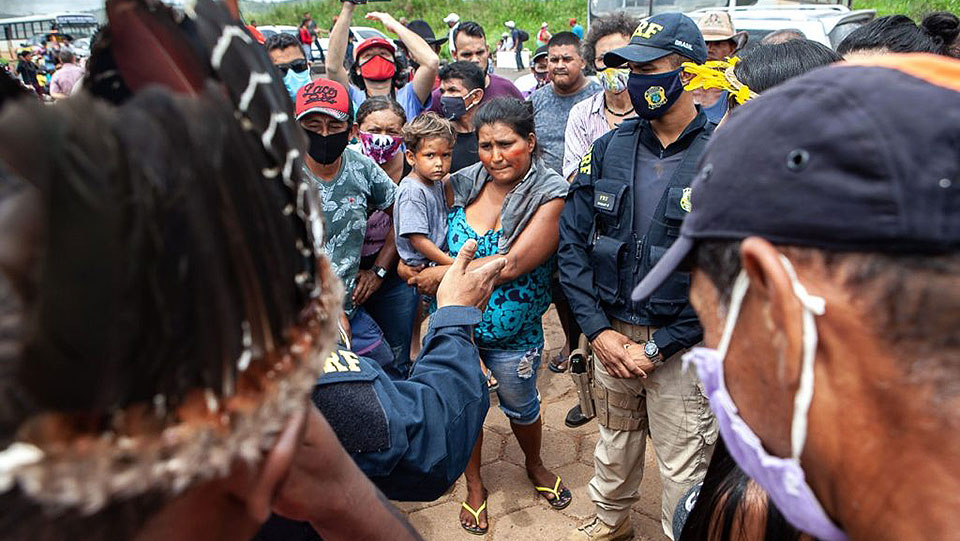
ALTAMIRA, Pará, Brazil (Nov. 9) — On Monday morning, Nov. 9, an estimated 150 fishermen, riverside inhabitants, local farmers and members of the indigenous Curuaya and Xipaya peoples from Altamira, Senator José Porfírio, Novo Brasil, Anapu, and Vitória do Xingu, five municipalities in the State of Pará, occupied both lanes of the Trans-Amazon Highway at the 27 kilometer marker to protest against Norte Energia (North Energy), a subsidiary of the Belo Monte hydroelectric plant. According to the demonstrators, they are demanding that the utility free enough water from November 2020 through March 2021 to make the annual fish spawn in the Volta Grande (Big Bend) of the Xingu (pron. Shingoo) River possible. Later the same morning, Highway Patrol officers conversed with the protestors but made no attempt to stop them.
The normal tidal flow of the Xingu’s Volta Grande, which comprises about a hundred kilometers, has been drastically altered since Belo Monte began to function. A massive amount of water is deviated by the power plant’s turbines. Norte Energia proposed to free up a volume of water considered far from sufficient for the reproduction of fauna by specialists from eight Brazilian universities (the “Panel of Specialists”), the Federal Public Ministry, IBAMA, and FUNAI.
According to the protesters, the low water level of the Volta Grande has impeded the spawning runs of the last two years, which has led to a vertiginous depopulation of river fauna and consequent nutritional and economic crises for those who live and depend on it. The situation has reached catastrophic levels since the start of the COVID-19 pandemic in March of this year.

In 2020, the Middle Xingu region suffered one of the most severe droughts of the past 50 years. Many of the Xingu’s tributary rivers dried up, resulting in piscine mortality and an accelerated loss of farmable land throughout the Volta Grande region. According to local sources, the water stress on the Middle Xingu area brought about by Belo Monte’s activity affected the production of food as well as the economic activity of families who sell some of what they grow.
The protest demonstration on November 9 demanded that IBAMA suspend Belo Monte’s license to operate until Norte Energia agrees to a flow rate of at least 16,000 cubic meters per second in the Big Bend area in March and April 2020 so that the reproduction of riverine fauna and flora is guaranteed during the spawning run.
The meeting
On Monday afternoon, representatives from all the communities met in Altamira[iv] with a FUNAI representative, with Thais Santi, a prosecutor from Federal Public Ministry (MPF) and with representatives from Equatorial, a company outsourced by Norte Energia, which was absent. According to the protestors, no concrete response was given by any of these attendees. The MPF affirmed that it is investigating the alleged fish mortality due to the drought and explained that it will take measures in relation to the tidal flow of the Xingu’s Volta Grande and the proposed “hydrogram” defended by Norte Energia. According to Prosecutor Santi, the MPF understands that the navigational difficulties and the paucity of fauna decried by fisherfolk and riverbank inhabitants is not a result of the drought but of Belo Monte’s water monopoly and requires an independent investigation and a public hearing. The FUNAI representative said only that he is aware of Norte Energia’s debt to the Indigenous peoples but that, unfortunately, he has been unable to persuade the company to make good on their commitments.
After the meeting, which they considered totally unsatisfactory, the community representatives returned to the site of the protest where they would remain until a negotiation session with representatives from Norte Energia, scheduled for Tuesday morning. Backed up traffic was allowed to pass after nightfall but protestors said the roadblock would be reinstalled if the result of the discussion with Norte Energia was unsatisfactory.
In court
Norte Energia sued for a volume of water, specifically for the use of the Belo Monte hydroelectric plant, that would diminish the normal tidal flow of the Volta Grande in the Xingu River by 80 percent. The company called this plan a “Consensual Hydrogram” and wanted to put it into effect beginning in November 2019. Because this “hydrogram” seemed completely impractical, IBAMA issued an order in January 2020, stipulating an alternative hydrogram that, as far as stimulating the reproduction of riverine fauna and the economic welfare of riverside communities is concerned, was, according to the protestors, as impractical as its predecessor. At the beginning of October, Norte Energia filed a lawsuit against IBAMA’s order, which was dismissed in the first instance. The company appealed this decision at the First District of the Federal Regional Tribunal.

Manifesto for a revived 2020 spawning run
“We, women and men who fish, who live by the riverside, who grow crops dependent on river water, who are Indigenous Curuayas and Xipayas have decided to risk our safety and that of our families in a peaceful but desperate act of civil disobedience in the midst of the COVID pandemic, because we have NO Alternative: the Xingu River is dying and we see NO WAY OUT but preserving our lives and those of our children and elders. In order to survive, we must convince competent authorities to end the Belo Monte power plant’s illegal consumption of the waters of the Xingu.
The Xingu’s drought this year, 2020, is one of the severest in recent history. Compared to last year, the river is almost 40 percent lower than it was last October, and many of the Xingu’s tributaries, like the Altamira, the Ambé, and the Trindade are shrinking. Now they look like stagnant lakes covered with dead fish.
The population of the Middle Xingu region depends on the river and its tributaries for fishing, transportation, for enough water to drink, to bathe, to cook, and to irrigate its crops. The current situation is taking on catastrophic proportions. Hundreds of families already hard hit by COVID-19 are not only going hungry but losing their very means of survival.
For the past two years, the misappropriation of water from the Xingu’s Volta Grande by Belo Monte’s turbines has made piscine spawning runs impossible, depriving the river of fish and turtles and the people who catch them from eating and selling them.
What is more, this year the drought has made navigation all but impossible with extraordinary outcroppings of rocks and stones that damage boats and motors. Crops are drying up and the water of both the river and its tributaries is totally unsuitable for drinking.
Apart from the gravity of the situation caused by negative climatic phenomena and intensified by the clearing and burning of the forest—that since the construction of Belo Monte, have placed Altamira at the top of the list of municipalities with the greatest number of environmental crimes in Pará state—the current picture of the Xingu’s calamity is not a surprise.

Innumerable studies and technical evaluations by sources such as IBAMA, FUNAI, MPF, and research institutes make explicit the social and environmental catastrophe produced by the hydroelectric intervention of the flow of the Volta Grande of the Xingu River. After analyzing documents produced by IBAMA technicians in 2009, the Federal Public Ministry concluded that there was no certainty that aquatic fauna and alluvial forests would be able to withstand the hydric stress that Belo Monte is imposing on the river. A group of researchers and specialists from eight well-known national universities and institutes concluded, at the end of 2019, that the flow rates of the “hydrogram” proposed during the licensing process of the Belo Monte power plant will make life on the Volta Grande of the Xingu impossible.
In October, Norte Energia allowed an average of 800 cubic meters of water per second to enter the Volta Grande area. However, the environmental impact study of the undertaking affirms that at least 15,000 cubic meters per second would be required for the reproductive locations of aquatic animals to be sufficiently inundated to permit spawning. Without an average flow of 13,000 cubic meters per second, aquatic turtles will not be able to gain access to tributary areas where they migrate seasonally in search of food.
FUNAI has already imposed conditions for the licensing of the Belo Monte power plant: that the company guarantee the maintenance of the ecological conditions necessary for physical permanence and cultural reproduction of the Juruna and Arara, Indigenous peoples of the Big Bend of the Xingu River. To these, we add the Curuaya, Xipaya, and other Indigenous inhabitants of the islands of the Xingu.
The original article can be accessed here.
Translated by Peter Lownds.










